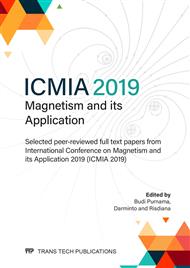[1]
C. Chen, S. Bao, B. Zhang, Y. Chen, W. Chen, c. Wang, Coupling Fe@Fe3O4 nanoparticles with multiple-walled carbon nanotubes with width band electromagnetic absorption performance, Appl. Surf. Sci. (2018).
DOI: 10.1016/j.apsusc.2018.10.148
Google Scholar
[2]
J. Xiong, Z. Xiang, J. Zhao, L. Yu, E. Cui, B. Deng, Z. Liu, R. Liu, W. Lu, Layered NiCo alloy nanoparticles/nanoporous carbon composites derived from bimetallic MOFs with enhanced electromagnetic wave absorption performance, Carbon N. Y. (2019).
DOI: 10.1016/j.carbon.2019.07.096
Google Scholar
[3]
Y. Wang, X. Gao, X. Wu, W. Zhang, C. Luo, P. Liu, Facile design of 3D hierarchical NiFe2O4/ N-GN/ZnO composite as a high performance electromagnetic wave absorber, Chem. Eng. J. 375 (2019) 121942.
DOI: 10.1016/j.cej.2019.121942
Google Scholar
[4]
S. Peng, Suyun Wang, Gazi Hao, Chao Zhu, Yan Zhang, Xiang Lv, Yubing Hu, Wei Jiang, Preparation of magnetic flower-like carbon-matrix composites with efficient electromagnetic wave absorption properties by carbonization of MIL-101(Fe), J. Magn. Magn. Mater. 487 (2019) 165306.
DOI: 10.1016/j.jmmm.2019.165306
Google Scholar
[5]
F. Meng, H. Wang, F. Huang, Y. Guo, Z. Wang, D. Hui, Z. Zhou, Graphene-based microwave absorbing composites : A review and prospective, Compos. Part B, 137 (2018) 260–277.
DOI: 10.1016/j.compositesb.2017.11.023
Google Scholar
[6]
H. Luo, R. Gong, X. Wang, Y. Nie, Y. Chen, V.G. Harris, Fe3O4 cladding enhanced magnetic natural resonance and microwave absorption properties of Fe0.65Co0.35 alloy flake, Journal of Alloys and Compounds. 646 (2015) 345-350.
DOI: 10.1016/j.jallcom.2015.05.208
Google Scholar
[7]
K. Chandra Babu Naidu, W. Madhuri, Microwave processed bulk and nano NiMg ferrites: A comparative study on X-band electromagnetic interference shielding properties, Mater. Chem. Phys. 187 (2017) 164–176.
DOI: 10.1016/j.matchemphys.2016.11.062
Google Scholar
[8]
C. Zhou, C. Wu, M. Yan, A versatile strategy towards magnetic/dielectric porous heterostructure with confinement effect for lightweight and broadband electromagnetic wave absorption, Chem. Eng. J. 370 (2019) 988–996.
DOI: 10.1016/j.cej.2019.03.295
Google Scholar
[9]
V. Nandwana, R. Zhou, J. Mohapatra, S. Kim, P.V. Prasad, J. P. Liu, V. P. Dravid, Exchange coupling in soft magnetic nanostructures and its direct effect on their theranostic properties, ACS Appl. Mater. Interfaces. 10 (2018) 27233–27243.
DOI: 10.1021/acsami.8b09346
Google Scholar
[10]
H.Y. Liu, Y.S. Li, Synthesis and microwave absorbing properties of Cobalt ferrite, IOP Conf. Series: Materials Science and Engineering. 292 (2018) 012062.
DOI: 10.1088/1757-899x/292/1/012062
Google Scholar
[11]
Z. Wang, J. Zou, Z. Ding, J. Wu, P. Wang, S. Jin, H. Bi, Magnetic and microwave absorption properties of Ni microcrystals with hierarchical branch-like and flowers-like shapes, Mater. Chem. Phys. 142 (2013) 119–123.
DOI: 10.1016/j.matchemphys.2013.07.003
Google Scholar
[12]
N. Wu, D. Xu, Z. Wang, F. Wang, J. Liu, W. Liu, Q. Shao, H. Liu, Q. Gao, Z. Guo, Achieving superior electromagnetic wave absorbers through the novel metal-organic frameworks derived magnetic porous carbon nanorods, Carbon N. Y. (2019).
DOI: 10.1016/j.carbon.2019.01.028
Google Scholar
[13]
A. Olad, S. Shakoori, Electromagnetic interference attenuation and shielding effect of quaternary Epoxy-PPy/Fe3O4-ZnO nanocomposite as a broad band microwave-absorber, J. Magn. Magn. Mater. 458 (2018) 335–345.
DOI: 10.1016/j.jmmm.2018.03.050
Google Scholar
[14]
H. Yang, T. Ye, Y. Lin, M. Liu, Excellent microwave absorption property of ternary composite: Polyaniline-BaFe12O19-CoFe2O4 powders, J. Alloys Compd. (2015).
DOI: 10.1016/j.jallcom.2015.08.272
Google Scholar
[15]
M. Rianna, M. Situmorang, C. Kurniawan, A.P. Tetuko, E.A. Setiadi, M. Ginting, P. Sebayang The effect of Mg-Al additive composition on microstructure, magnetic properties, and microwave absorption on BaFe12-2xMgxAlxO19 (x=0–0.5) material synthesized from natural iron sand, Mater. Lett. 256 (2019) 126612.
DOI: 10.1016/j.matlet.2019.126612
Google Scholar
[16]
P. Sardarian, H. Naffakh-Moosavy, S.S.S. Afghahi, A newly-designed magnetic/dielectric [Fe3O4/BaTiO3@MWCNT] nanocomposite system for modern electromagnetic absorption applications, J. Magn. Magn. Mater. 441 (2017) 257–263.
DOI: 10.1016/j.jmmm.2017.05.074
Google Scholar
[17]
H. Zhang, D. Zeng, Z. Liu, The law of approach to saturation in ferromagnets originating from the magnetocrystalline anisotropy, J. Magn. Magn. Mater. 322 (2010) 2375-2380.
DOI: 10.1016/j.jmmm.2010.02.040
Google Scholar
[18]
L. Zhang, J. Zhai, W. Mo, X. Yao, Electric and magnetic properties of (x)CoFe2O4-(1-x)BaTiO3 thick film prepared by electrophoretic deposition technique, Solid State Sci. 13 (2013) 321–325.
DOI: 10.1016/j.solidstatesciences.2010.11.023
Google Scholar
[19]
M. Atif, S. Ahmed, M. Nadeem, M.K. Ali, M. Idrees, R. Grössinger, Role of competing phases in the structural , magnetic and dielectric relaxation for (1-x)CoFe2O4-(x) BaTiO3 composites, Ceram. Int. (2016).
DOI: 10.1016/j.ceramint.2016.06.082
Google Scholar
[20]
M. Atif, M. Nadeem, W. Khalid, Z. Ali, Structural, magnetic and impedance spectroscopy analysis of (0.7)CoFe2O4+(0.3)BaTiO3 magnetoelectric composite, Mater. Res. Bull. 107 (2018) 171–179.
DOI: 10.1016/j.materresbull.2018.07.026
Google Scholar


